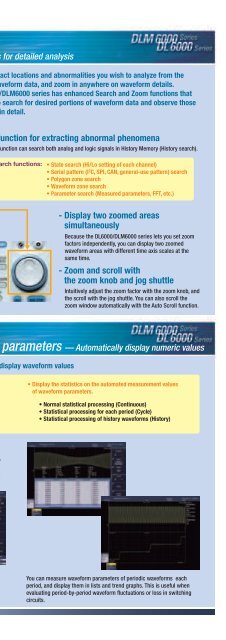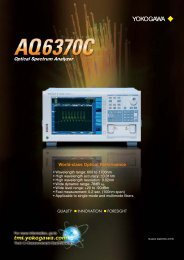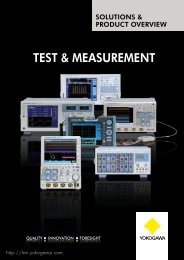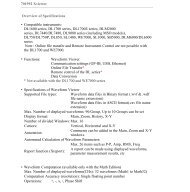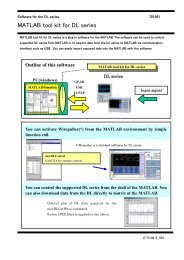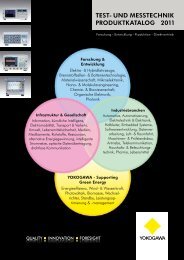Digital Oscilloscope Mixed Signal Oscilloscope
Digital Oscilloscope Mixed Signal Oscilloscope
Digital Oscilloscope Mixed Signal Oscilloscope
You also want an ePaper? Increase the reach of your titles
YUMPU automatically turns print PDFs into web optimized ePapers that Google loves.
Includes cost- and time-saving features for embedded systems development — Never miss the waveforms you want. Quickly reveal the information you need. —<br />
For evaluation of embedded systems that are becoming increasingly complicated, engineers want oscilloscopes that not only<br />
display waveforms, but also elucidate the meanings of those waveforms and aid in their understanding.<br />
The DL6000/DLM6000 series shrink R&D and evaluation times and help reduce development costs for embedded systems.<br />
- Computing and observing<br />
actuator drive waveforms<br />
in real time<br />
You can observe signals such as control signals<br />
to actuators and PWM waveforms that drive<br />
motors, and observe the resultant physical<br />
waveforms in real-time as they are converted<br />
through high-speed computation.<br />
For particularly noisy signals, you can reject the<br />
noise with highly configurable input filters prior<br />
to observation<br />
- Real-Time Serial Bus Analysis<br />
In systems that control multiple devices using I 2 C, SPI, CAN, LIN, and other serial busses, engineers must verify<br />
whether each device is operating as designed. With the DL6000/DLM6000, you can capture specific commands and<br />
data on the serial bus with serial bus trigger functions, analyze the communication with protocol analysis functions,<br />
and simultaneously confirm the signal waveforms on the bus and the behavior of the controlled devices.<br />
Decode<br />
- Evaluation of SD card<br />
busses/SDIO<br />
Waveform<br />
The following information related<br />
to specific commands can be displayed<br />
simultaneously in real time:<br />
• Waveforms<br />
• Protocols<br />
• Decodes<br />
(information corresponding<br />
to the waveforms<br />
and protocols)<br />
Protocol<br />
If you observe clock and command signals on<br />
analog channels and data bus (4-bit) with logic<br />
input, you can observe the behavior of<br />
commands and data transmission all at the<br />
same time.<br />
PWM Waveform<br />
Filtered PWM Waveform (LPF)<br />
Example of<br />
Embedded System<br />
Actuator<br />
Sensor<br />
Other Module/Device<br />
LIN<br />
CAN<br />
I 2 C<br />
SPI<br />
UART<br />
USB<br />
LAN<br />
SD Card<br />
Serial Bus<br />
Interface<br />
- Evaluation of switching<br />
power supply circuit<br />
characteristics<br />
PCIe<br />
Sensor<br />
ADC<br />
Internal Bus<br />
Controller<br />
Display<br />
Power<br />
Actuator<br />
DAC<br />
I/O<br />
PCI<br />
- Evaluating A/D conversion circuits<br />
with Virtual D/A computation<br />
Not only can you observe the digital data before and after data conversion on<br />
logic input channels as waveforms, but you can also wholly convert the data to<br />
analog waveforms with Virtual D/A computation, display the waveforms, and<br />
perform additional computations on them.<br />
• Conversion computation of up to 32 bits<br />
• <strong>Digital</strong> filtering computations even on waveforms already converted from data<br />
• High-speed processing enables real-time observation of computed waveforms<br />
GPIO<br />
Memory<br />
RAM<br />
ROM<br />
Flash<br />
Control Panel<br />
With clock synchronization, you can display<br />
logic signals on the bus (state display),<br />
D/A conversion-computed waveforms,<br />
and low-pass filtering of these waveforms in real time.<br />
- Check PCI bus performance with 32-bit logic input<br />
You can measure the main signals using 32-bit logic + 4 analog channels to check control signal statuses or check<br />
transferring on the PCI bus.<br />
The number of burst transfers on the PCI bus can usually be ascertained by counting the number of CLK pulses that<br />
occur during the period when TRDY is Lo. However, the DLM6000 series has a Pulse Count function that counts the<br />
number of clocks automatically.<br />
CLK<br />
TRDY#<br />
Counting the number of clocks<br />
Count : 64<br />
- Parallel bus observation<br />
Primary<br />
Secondary<br />
The DLM6000 enables observation and<br />
analysis of up to 32-bit logic signals along<br />
with 4 channels of analog signals, and this is<br />
useful for verifying operations on a parallel<br />
bus.<br />
• State Display function<br />
• Bus Display function<br />
(binary, hexadecimal, symbol)<br />
Zoom1<br />
Bus and State Display:<br />
Normalization based on the<br />
specified clock edge<br />
- Analysis of serial interface memory communications<br />
CLK<br />
Data<br />
Counting clock edge<br />
Zoom2<br />
Counting the number of PCI burst transmissions<br />
Bit arrangement in<br />
each group including<br />
MSB/LSB can be set<br />
independently of the<br />
bit arrangement of the<br />
logic probe<br />
• Trigger on specific commands<br />
(serial pattern trigger)<br />
• Easy-to-read displays of data bus values<br />
in binary and hexadecimal<br />
(logic signal Bus Display function)<br />
The DL6000/DLM6000 series has an<br />
available option for power supply analysis,<br />
and you can evaluate switching loss and<br />
analyze the SOA (safe operating area)<br />
while making waveform observations with<br />
a combination of differential and current<br />
probes.<br />
Flash memory that uses I 2 C or SPI as its interface is<br />
often found in embedded systems. Using the<br />
DL6000/DLM6000 which can simultaneously display<br />
three sets of data (waveforms, protocols, and<br />
decodes) in real-time means highly efficient<br />
verification of system operations, including the status<br />
of the serial bus.<br />
10<br />
11


